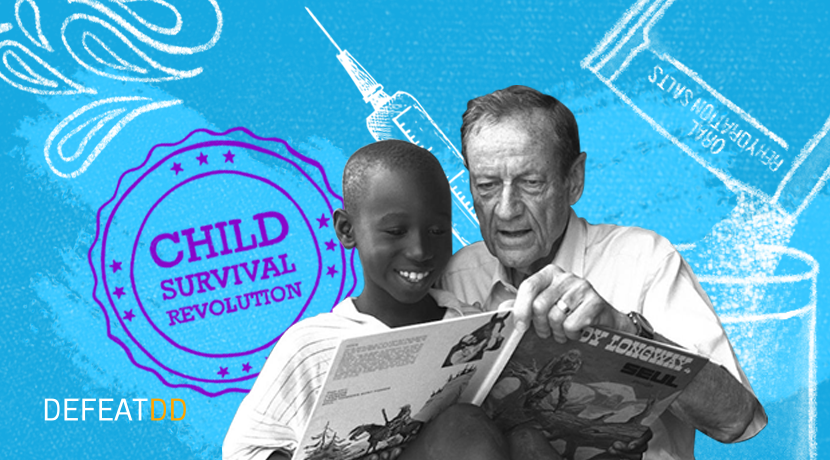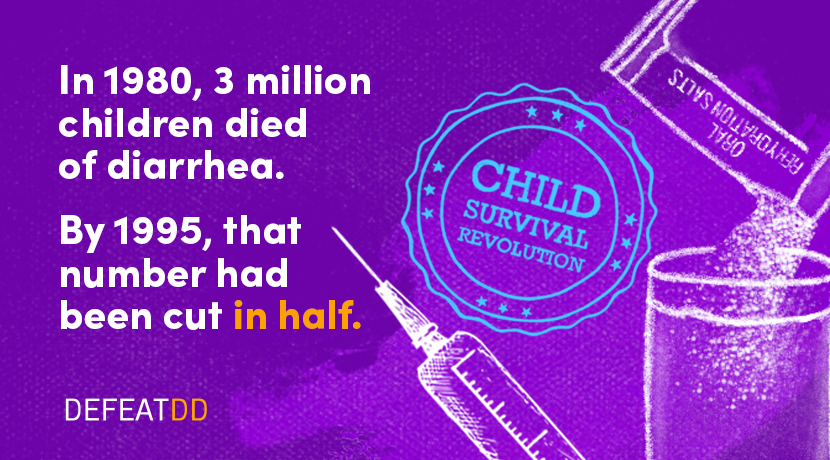
‘Mad Man’ or Hero? The Advocate Who Staged a Revolution Against Deadly Diarrhea

In 1985, a man named Jim Grant, the relatively new director of UNICEF, traveled to the Dominican Republic to meet with President Salvador Jorge Blanco. Blanco was apparently taken by Grant’s charisma and hosted a state dinner in which he asked Grant to make a formal speech. Accompanying Grant on stage were President Blanco and a handful of men standing stiffly in military-type regalia.
During the speech, Grant began talking about how the Dominican Republic could save more children by focusing on what were becoming known as his ‘twin engines’ of child survival – oral rehydration solution to prevent deaths from diarrhea, and immunization against childhood diseases.
At some point during the speech, Grant paused and reached into his pocket to pull out a roll of red and blue stickers. Each sticker had “Child Survival Revolution” printed on it. Turning to the President on stage, he began pasting the stickers all over the President’s suit.
Returning to the microphone, he said ‘You know Mr. President,’ Grant said, ‘the Child Survival Revolution also needs its generals. And I want to create you a five-star general of the Child Survival Revolution.’
‘He’s Mad’
Jim Grant’s audacious story, which would eventually make him one of the most important global health leaders in history, began about five years earlier at an inauspicious UNICEF weekend conference at the Sterling Forest conference center in upstate New York.
Grant’s speeches at Sterling that weekend would instigate one of the most transformative periods in global public health – a 15-year span that revolutionized global health and, as Nick Kristoff wrote in 2008 “probably saved more lives than were destroyed by Hitler, Stalin and Mao combined.”
Millions of those lives saved would be from diarrhea, which in 1980 still took the lives of 3 million children annually.
But before that, Jim Grant would alarm and anger many of his colleagues.
Peter Adamson was at Sterling Forest that weekend. Adamson was a campaigner working for UNICEF and Grant had recently been named its new Executive Director. At the time, according to Adamson, UNICEF was a much smaller initiative than today, providing programs to a few hundreds or thousands of children – certainly not millions – and with a much smaller budget.
That weekend, Jim Grant announced that he wanted a sea change at UNICEF, and he said so in the strongest terms possible. In the book Jim Grant, UNICEF Visionary, Adamson described his impassioned call to rapidly advance UNICEF’s impact on the world.
We have a few hundred million dollars, he says. That’s three or four cents for every child in the developing countries. We can’t change the world with that.
In any case, what changes the world isn’t budgets and projects and programmes. What changes the world, is a major shift in thinking, brought about by advocacy, new ideas, new visions.
According to Adamson, the “alarm and frustration” with Jim Grant’s statements were palpable as his words spread to UNICEF offices around the world. Grant was suggesting upheaval in how the organization approached child health. At that time, the idea of advocacy for child health was new, and not necessarily welcomed.
Adamson says that in the days and weeks after that weekend, “I couldn’t tell you how many times I heard the phrase ‘he’s mad’.”
Facing Down a Killer with Sugar and Salt
Despite doubt and mounting frustration about his bold approach, within months of the Sterling Forest weekend Jim Grant had marked a spot on the child-health map where he would stake his claim.
Diarrhea.
In 1980, 14 million young children were dying every year in low-income countries – and diarrheal diseases led the count with three million deaths each year.
Trials had recently shown that 70 percent of diarrhea deaths could be prevented with oral rehydration solution (ORS), a simple sugar-and-salt measure that cost pennies. But the treatment was largely unknown in low-income countries, and no major program had taken it on as a singular cause.
Jim Grant became the first high-profile leader to champion ORS. To the chagrin of many of his colleagues, he set a goal that ORS should be available to at least half the families in the developing world within a few years.
As Adamson describes, Grant did his part to make this goal a reality. He traveled everywhere with an ORS packet. He met with political and health leaders, finance ministers, and aid workers. Central to every conversation was his pitch for ORS, which he would demonstrate while citing statistics on lives saved and cost-effectiveness of making the packets widely available.
His tireless campaigning worked. By 1990, due to Grant’s advocacy as well as to increasing commitment by UNICEF, WHO, and other aid groups, an astounding two-thirds of families in low-income countries had access to ORS. That increase in access to treatment amounted to 1.5 million children’s lives saved from diarrhea each year.
Immunization: The Second ‘Engine’ of the Revolution
Grant’s second key issue was immunization. In addition to diarrhea, contributing to the mounting death toll of under-fives were preventable diseases like measles, tetanus, whooping cough, and pneumonia.
It was clear that vaccines that were already available to the wealthiest countries could easily prevent 3.4 million more child deaths. Yet only about 15 percent of children in the poor world were receiving vaccinations at the time.
Grant challenged leaders of the world to double immunization levels – to 40 percent by the mid-1980s. At the time, this sounded ridiculous to many, given that systems, supply chains, and staffing were highly insufficient to meet such an effort. But Grant went even further, saying coverage should then be doubled again by the end of the 1980s – to 80 percent.
Seemingly nothing would stop Jim Grant when it came to reaching these goals – not even civil war. At one point, he and the UNICEF office in El Salvador, partnering with the Catholic Church, managed to negotiate three-days of cease fire in a civil war between guerrillas and the government in order to immunize the nation’s children.
By 1990, the target had been reached. Nearly all countries, 129 in total, had achieved child vaccination rates of over 80 percent. More robust systems were in place, and childhood immunization had become a norm. Millions more lives were saved each year, as a result of focus, commitment, and increased political will.

A Commitment to the End
Grant’s methods remained in question throughout his career. Chief among them was the merit of focusing on individual interventions (“vertical” programs) as opposed to holistic approaches (“horizontal” programs). This debate remains alive today. Grant was also willing to ignore political realities in a quest for child survival outcomes. He met with despots and dictators, holding a steadfast belief he could appeal to humanitarian instincts of even the most hardened.
During Grant’s tenure as Executive Director of UNICEF, according to Adamson, the number of countries where UNICEF worked doubled, the size of UNICEF’s field staff tripled, and its income quadrupled. Grant continued to see advocacy and program delivery as two sides of the same coin. He was continuously focused on measurable goals, simple solutions, and relentless activism.
Until the very end. Jim Grant contracted cancer in the mid-1990s. But he rarely talked about his illness. Those close to him say he was still planning the agenda for a meeting of the UNICEF board meeting when he died in a hospital in upstate New York in 1995. The place of his death was not far from Sterling Forest.
Building on a Legacy to Fight Diarrhea
Since 1995, more stunning progress has been made in the realm of child survival. The number of child deaths from diarrhea has been cut yet again. Zinc has joined ORS as a twin treatment to further limit the damage from dehydration.
And rotavirus vaccines are saving hundreds of thousands of lives, with that number growing each year.
As COVID-19 rages around us today and many lives and livelihoods are needlessly lost, it can be challenging to find hope. Reflecting on the history of global health, and its heroes, can help. Today our world remains full of leaders and entrepreneurs, and many millions more critical helpers and servants. These individuals have the power to help, heal, and mobilize every day. In time, they may yet catalyze a sea change that can allow many more to survive, and thrive, in our interconnected world today.


